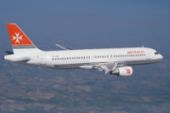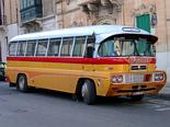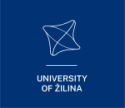
Conference Location
History
 Malta, officially the Republic of Malta, is a small and densely populated island nation consisting of an archipelago of seven islands in the middle of the Mediterranean Sea. Malta lies directly south of Sicily, east of Tunisia and north of Libya. The country's official languages are Maltese and English. Roman Catholicism is the most practised religion. The islands constituting the Maltese nation have been ruled by various powers and fought over for centuries. Malta has been a member state of the European Union since 2004 and it is currently the smallest EU country both in population and in area. Malta is the only nation in the world that has collectively been awarded the George Cross for conspicuous gallantry in WWII as a part of the British Empire, and its flag bears a replica of that award.
Malta, officially the Republic of Malta, is a small and densely populated island nation consisting of an archipelago of seven islands in the middle of the Mediterranean Sea. Malta lies directly south of Sicily, east of Tunisia and north of Libya. The country's official languages are Maltese and English. Roman Catholicism is the most practised religion. The islands constituting the Maltese nation have been ruled by various powers and fought over for centuries. Malta has been a member state of the European Union since 2004 and it is currently the smallest EU country both in population and in area. Malta is the only nation in the world that has collectively been awarded the George Cross for conspicuous gallantry in WWII as a part of the British Empire, and its flag bears a replica of that award.
|
Malta has been inhabited since around 5000 BC. A significant prehistoric Neolithic culture marked by Megalithic structures existed on the islands during its pre-history. The earliest structures, dating from 3500 BCE predate the Pyramids of Giza by a millennium. The temple of Ħaġar Qim, which dates from between 3200 and 2500 BCE, stands on a hilltop on the southern edge of the island of Malta. Adjacent to Ħaġar Qim, lies another remarkable temple site, Mnajdra. The society that built these structures eventually died out or at any rate disappeared. Phoenicians colonized the islands around 1000 BC, using them as an outpost from which they expanded sea explorations and trade in the Mediterranean. A nice introduction to this period in Malta's history is a visit to the National Museum of Archaeology in Valetta. |
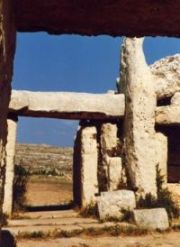
Mnajdra Temples, Malta |
The islands later came under the control of Carthage (400 BC) and then of Rome (218 BC). The islands prospered under Roman rule, during which time they were considered a Municipium and a Foederata Civitas. Many Roman antiquities still exist, testifying to the close link between the Maltese inhabitants and the people of Rome. In AD 60, the islands were visited by Saint Paul, who is said to have been shipwrecked on the shores of the aptly-named "Saint Paul's Bay". Studies of the currents and prevalent winds at the time however, render it more likely that the shipwreck occurred in or around St. Thomas Bay in Marsaskala.

After a period of Byzantine rule (4th to 9th century) and a probable sack by the Vandals, the islands were conquered by the Arabs in AD 870. The Arabs, who generally tolerated the population's Christianity, introduced the cultivation of citrus fruits and cotton, and irrigation systems. Arab influence can be seen most prominently in the modern Maltese language, which also contains significant Romance influences, and is written in a variety of the Latin alphabet.
The period of Arab rule lasted until 1091, when the islands were taken by the Sicilian Normans. Subsequent rulers included the Angevine, the Hohenstaufen, and the Aragonese (1283). The Maltese nobility was established during this period; some of it dating back to 1400. About 32 noble titles remain in use today, of which the oldest is the Barony of Djar-il-Bniet e Buqana.
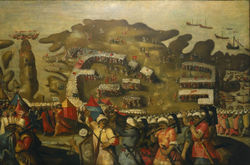
The Great Siege of Malta |
In 1530, Holy Roman Emperor Charles V of Spain gave the islands to the Order of Knights of the Hospital of St John of Jerusalem in perpetual lease. (The Kingdom of Aragon had owned the islands as part of its Mediterranean empire for some time). These knights, a military religious order now known as the "Knights of Malta", had been driven out of Rhodes by the Ottoman Empire in 1522. They withstood a full-blown siege by the Ottoman Turks in 1565. The Turks, at that time, were considered to be a great power. After this they decided to increase the fortifications, particularly in the inner-harbour area, where the new city of Valletta, named after Jean Parisot de la Valette, was built. |
Their reign ended when Malta was captured by Napoleon en route to his expedition of Egypt during the French Revolutionary Wars in 1798. As a ruse, Napoleon asked for safe harbour to resupply his ships, and then turned his guns against his hosts once safely inside Valletta. The Grandmaster, knew that he could only allow a few ships at a time to enter the harbour, due to the Treaty of Trent. Grand Master Ferdinand von Hompesch zu Bolheim capitulated, and Napoleon stayed in Malta for a few days, during which he systematically looted the movable assets of the Order, and established an administration controlled by his nominees. He then sailed for Egypt, leaving a substantial garrison in Malta.
|
The occupying French forces were unpopular, however, due particularly to their negative attitude towards religion. The financial reforms and the religious reforms did not go down well with the citizens. The Maltese rebelled against them, and the French were forced behind the fortifications. Great Britain, along with the Kingdom of the Two Sicilies, sent munitions and aid to the rebels. Britain also sent her navy, which instigated a blockade of the islands. The isolated French forces, under General Claude-Henri Belgrand de Vaubois, surrendered in 1800, and the island became a British protectorate, being presented by several Maltese leaders to Sir Alexander Ball. In 1814, as part of the Treaty of Paris, Malta officially became a part of the British Empire, and was used as a shipping way-station and fleet headquarters. Malta's position half-way between Gibraltar and the Suez Canal proved to be its main asset during these years, and it was considered to be a most important stop on the way to India. |
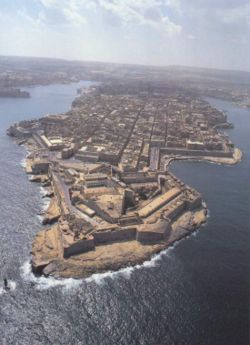
Aerial view of Valletta |
In the early 1930s the British Mediterranean Fleet, which was at the time the main contributor for the commerce on the island, was moved to Alexandria as an economy measure. Malta played an important role during World War II, owing to its vicinity to Axis shipping lanes. The bravery of the Maltese people in their long struggle against enemy attack moved H.M. King George VI to award the George Cross to Malta on a collective basis on 15 April 1942, "to bear witness to a heroism and devotion that will long be famous in history". A replica of the George Cross now appears in the upper hoist corner of the Flag of Malta, outlined in red.
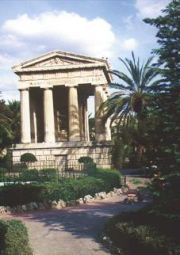 |
After the war, and after a short period of political instability due to the Malta Labour Party's unsuccessful attempt at 'Integration with Britain', Malta was granted independence on September 21, 1964 (Independence Day). Under its 1964 constitution, Malta initially retained Queen Elizabeth II as Queen of Malta, with a Governor-General exercising executive authority on her behalf. On December 13, 1974 (Republic Day), however, it became a republic within the Commonwealth, with the President as head of state. A defence agreement signed soon after independence (and re-negotiated in 1972) expired on March 31, 1979 (Freedom Day) when the British military forces were withdrawn. Malta adopted an official policy of neutrality in 1980 and, for a brief period was a member of the Movement of Non-Aligned Countries. In 1989, Malta was the venue of an important summit between US President Bush and Soviet leader Gorbachev, their first face-to-face encounter, which signalled the end of the Cold War. |
Malta joined the European Union on May 1, 2004. It intends to join the Eurozone in 2008.
If you want to experience a complete multimedia walk-through of the history of Malta, then I can recommend visiting The Malta Experience.
Geography
Malta is an archipelago in the central Mediterranean Sea, some 93 km south of Sicily. Only the three largest islands Malta Island (Malta), Gozo (Għawdex), and Comino (Kemmuna) are inhabited. The smaller islands, such as Filfla, Cominotto and the Islands of St. Paul are uninhabited. Numerous bays along the indented coastline of the islands provide good harbours. The landscape is characterised by low hills with terraced fields. The highest point is at Ta' Dmejrek on Malta Island at 253 metres (830 ft) near Dingli. Although there are some small rivers at times of high rainfall, there are no permanent rivers or lakes on Malta. However some watercourses are found randomly around the island that have fresh water running all year round. Such places are Baħrija, Imtaħleb and San Martin. Running water in Gozo is found at Lunzjata Valley.

The Malta Channel to the north separates Malta from the island of Sicily, the largest Italian isle.
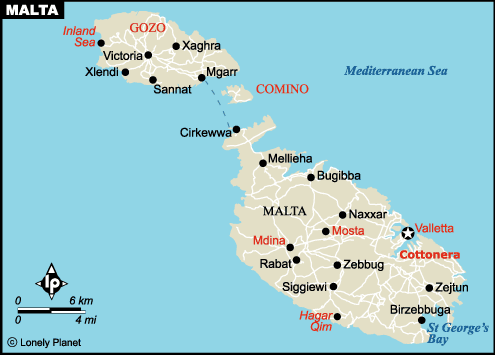
More detailed maps are linked here as a jpg file (where you can zoom in) and as a pdf file .
.
Climate
Malta has an excellent climate, reaching up to 30°C (86°F) in midsummer (July to August). The lowest average daily temperature, about 15°C (59°F), occurs during January. Rainfall is heaviest from November to February, though it's low all year-round.
Culture
|
Malta boasts a rich tri-cultural society where Mediterranean want mixes freely with Italian charm and Anglo-Saxon efficiency. English is an official language along with Maltese. Catholicism is the principal religion and is also the custodian of many quaint traditions. Magnificent baroque churches characterise the Maltese skyline, each marking a town or village. The Maltese summer is a festival of light and colour thanks to the many village feast in honour of the local patron saints. |
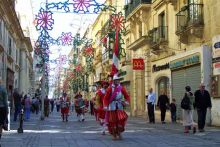 |
Many linguists trace the origin of Maltese to the Phoenician occupation of the islands. Maltese, a Semitic language, has survived the influence of Romance languages for hundreds of years, though it bears traces of English, French, Italian and Spanish.

Valletta, which is an UNESCO heritage site, is Malta’s capital city. The city was built by the Knights of the Order of St. John in the 16th and 17th centuries, and is home to the most important museums, the Grandmaster’s Palace, and the celebrated St. John’s Co-Cathedral.
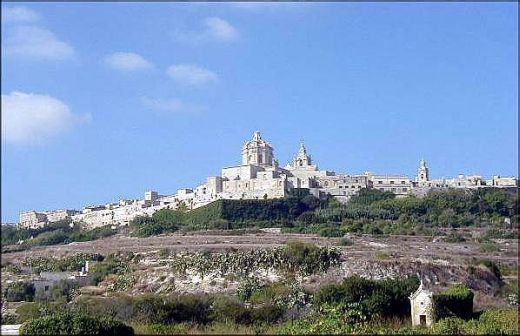
The 3000-year-old city of Mdina, (my favorite city, btw) once the political centre of Malta, is filled with Norman and baroque buildings and narrow streets. Perched on a rocky outcrop about 15km (9mi) west of Valletta, the so-called Citta Notabile - Noble City - has a commanding view of the island.
In the last couple of years Malta has also become the location of choice for some big Hollywood productions, like Popeye, Gladiator, Troy and Munich. From the movie Popeye, you can still visit Popeye village. Another worthwhile place to visit is the Hypogeum: an underground Neolithic temple.
Parts of this text were copied from 
Conference Venue
The ESM'2007 conference is held at the Westin Dragonara Hotel. St.Julian's. Below is the address and for more information about the hotel itself and its immediate vicinity check the hotel page.
| Westin Dragonara Hotel Dragonara Road St. Julians STJ 02, Malta  Tel: +356.21.381.000 Tel: +356.21.381.000 Fax: +356.21.381.347 Fax: +356.21.381.347 Email:westin.dragonara@westin.com Email:westin.dragonara@westin.comCheck in: 3:00 PM Check out: 12:00 PM |
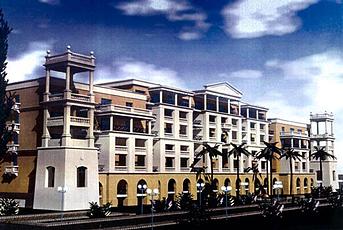 |
Some pictures of St.Julian's, which are in sharp contrast with the tranquil cities of Valetta and Mdina. St.Julian's is the new Malta (forgive the pun), vibrant and alive 24 hours a day.
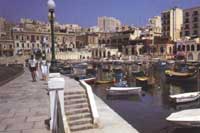 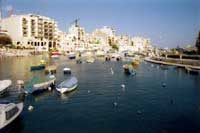 |
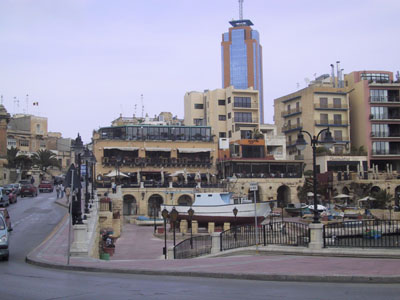 |
How to get to Malta 
By Plane |
When arriving in Malta, you will arrive at Malta International Airport in Luqa, either by flying Air Malta or any other European Carrier. At the airport you can transfer to a bus (or use this link or this one) or take a taxi to the hotel. |
By Ferry |
Several major shipping lines provide direct links between Sicily, a number of major Mediterranean ports and Valetta, such as Grimaldi Lines, Viamare, HixTravel, VirtuFerry... |
By Bus |
Once you are on the island, it is very cheap and easy to use the different bus lines to get about. Information about the buses can be found by using the following links:Malta Transport, The Public Transport Association and Malta Info. You can download an overview of the Malta bus lines here in gif format and here in pdf format If you are a classic car enthusiast then Malta is your treasure trove for spotting vintage busses. |
By Taxi |
Information on taxis can be found on Maltatransport, and booking taxis can be done from: Resorttaxi and Holiday Malta. Taxis are freely available on the islands. |
By Car |
Several Companies provide car hire like, Maltacar, Malta-Car-Hire, Aquariusrentacar and Jscarhire
|
On Foot
|
When you are in St.Julian's itself, you can easily walk to the hotel, as you can see from the maps on the hotel page. |
Beware
 Maltese Currency is not yet the EURO, although the EURO is already accepted in many places. To convert currencies use, the following currency converter.
Maltese Currency is not yet the EURO, although the EURO is already accepted in many places. To convert currencies use, the following currency converter.
When you bring your PC or other equipment to Malta be aware that electricity is 240 volts AC, 50Hz. and that UK-style three-pin plugs are in use.
Useful links
- Official Malta links
- Malta.Com Website
- Malta Atlas Website
- Malta Information Website
- Destination Malta website
- Visit Malta website
- Europe for visitors info on Malta
- Only Tours Website
- Garden View Malta Website
- Bluemalta Website
- Flights to Malta information website
- By train and ferry to Malta
- Information about Mdina
- Malta Hotel Information
- Malta Bookings - Hotels in Malta

